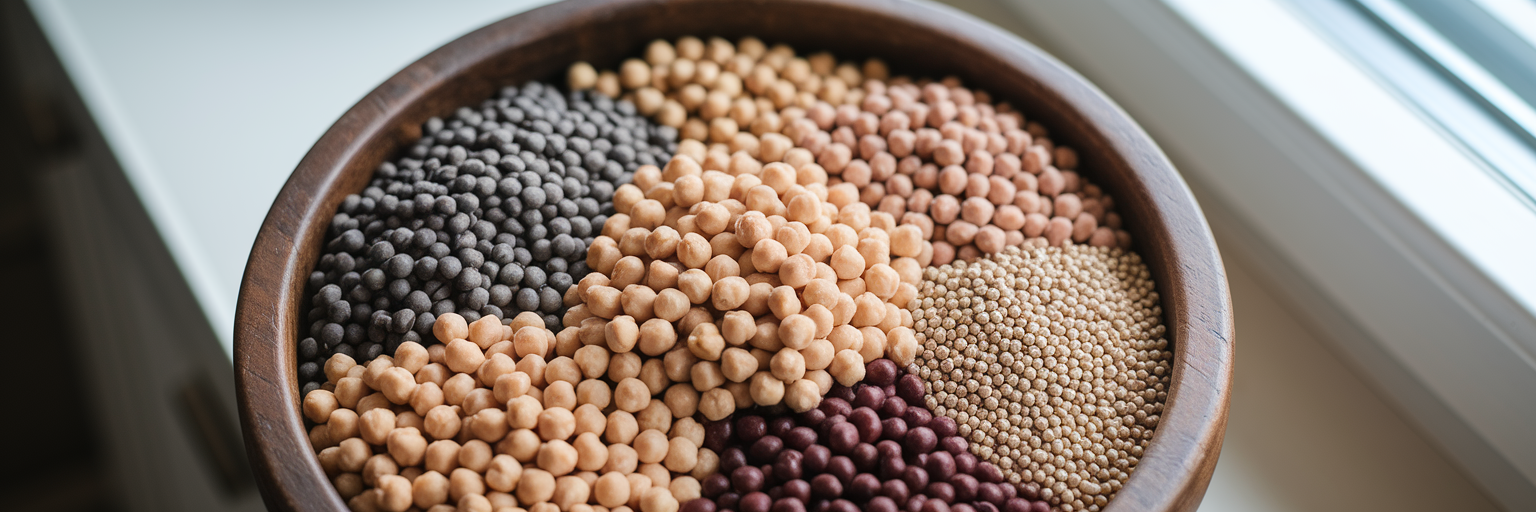The Environmental Price of Protein
Every meal on your plate has a story. It begins on a farm and travels through processing, packaging, and transport before it reaches your kitchen. That entire journey leaves a footprint on our planet. While we often think about the impact of cars or factories, the food we eat plays a huge role in environmental health. In fact, the choices we make at the grocery store can have a surprisingly powerful effect.
To put it in perspective, a comprehensive analysis highlighted by the BBC found that livestock farming is responsible for about 57% of all greenhouse gas emissions from food production. In stark contrast, plant-based foods contribute only 29%. That single statistic reveals a massive opportunity for change, starting right in our own kitchens.
Understanding the environmental impact of vegan protein versus animal sources isn't about assigning blame. It's about empowerment. When you know the true cost of your food, you can make choices that better align with your values. This guide is here to walk you through the facts, helping you see how simple swaps can contribute to a healthier planet. For anyone starting that journey, our blog is a great resource for information and inspiration.
Comparing Carbon Footprints

When we talk about the carbon footprint of meat, we're discussing more than just carbon dioxide. The "footprint" of food production includes all greenhouse gases released during its lifecycle. This is especially important when comparing plant based protein vs animal protein, because animal agriculture produces significant amounts of methane and nitrous oxide, gases that are far more potent at trapping heat than CO2.
Cattle, for instance, release large quantities of methane simply through their digestive process. Additionally, the fertilizers used to grow massive amounts of animal feed release nitrous oxide into the atmosphere. These factors combine to make animal protein incredibly emission-intensive. The numbers are quite telling. Studies show that shifting to a vegan diet can reduce your food-related emissions by around 43%. The difference is even more dramatic for specific swaps. Choosing a plant-based alternative over beef can slash associated emissions by up to 90%.
This huge gap comes down to efficiency. Raising animals requires vast resources, from clearing land for grazing to growing crops specifically for feed. Plant-based proteins, on the other hand, use resources far more directly. The table below offers a clear visual breakdown of this difference.
| Protein Source | Greenhouse Gas Emissions (kg of CO2eq per kg of product) | Primary Emission Source |
|---|---|---|
| Beef (Beef Herd) | 99.48 kg | Methane from digestion, land use change |
| Chicken | 9.87 kg | Feed production, manure management |
| Peas | 0.98 kg | Farming inputs, processing |
| Lentils | 0.9 kg | Farming inputs, low land use |
Data sourced from Our World in Data, based on a comprehensive meta-analysis by Poore & Nemecek (2018). Figures represent global averages and can vary based on specific farming practices.
The Land and Water Equation
Beyond the air we breathe, our protein choices have a profound impact on the land we live on and the water we drink. Animal agriculture is the single largest user of agricultural land globally. It's easy to picture sprawling fields for grazing, but a huge portion of that land is dedicated to growing feed crops like corn and soy, which are then fed to livestock. This system is incredibly inefficient from a resource perspective.
This is where eco friendly protein options truly shine. According to research from the Good Food Institute, plant-based meat alternatives have, on average, an 89% lower land use impact than conventional beef. Think about that for a moment. We could produce the same amount of protein using a fraction of the land, freeing up ecosystems to recover and thrive.
The story is just as compelling when we look at water. The "water footprint" of a food measures the total volume of freshwater used to produce it. Raising livestock is a thirsty business, requiring water for the animals to drink, to clean facilities, and most significantly, to irrigate the crops grown for their feed. The GFI's research also found that some plant-based meat alternatives can reduce water usage by as much as 99% compared to beef. For anyone living in drought-prone areas like California or the Southwest, this isn't just an abstract number. It represents a tangible way to conserve a precious resource. Making the switch is easier than you think, and to help you get started, we've put together a few easy vegan protein recipes you'll actually crave.
A Closer Look at Plant-Based Sourcing

While the data clearly favors plants, it's also true that not all vegan proteins are created equal. The environmental footprint of sustainable protein sources depends on several factors, including farming methods, processing intensity, and transportation distance. A bag of locally grown lentils will naturally have a smaller footprint than a highly processed product shipped across the country.
Whole plant proteins like beans, chickpeas, and lentils are champions of sustainability. They require minimal processing and often contribute to soil health through nitrogen fixation. More processed options, like protein powders or meat alternatives, require energy for manufacturing. However, it's important to maintain perspective. Even with processing, a well-formulated option like our Chocolate Vegan Protein offers a significantly lower environmental footprint than its dairy-based counterparts like whey.
High-quality brands are mindful of their impact. They focus on sourcing ingredients from farms that use regenerative practices like crop rotation, which improves soil biodiversity and reduces the need for chemical inputs. They also work to make their production processes as efficient as possible. For those looking for convenient and high-quality options, exploring a range of our plant-based products can be a great next step toward a more sustainable diet without sacrificing convenience.
How Your Choices Create Change
It can be easy to feel like one person's choices don't make a difference, but when it comes to food, the collective impact is enormous. A study published in Nature found that adopting a vegan diet is one of the most effective ways an individual can reduce their environmental impact, potentially cutting food-related emissions, land use, and water pollution by up to 75%. The benefits of a vegan diet extend directly from your plate to the planet.
Making a change doesn't have to be an all-or-nothing decision. Small, consistent steps can lead to significant results. Here are a few simple ideas to get you started:
- Start with "Meatless Mondays." It's a simple way to build a new habit without feeling overwhelmed.
- Swap ingredients in familiar recipes. Try using lentils or mushrooms instead of ground beef in your next batch of tacos or pasta sauce.
- Experiment with one new plant-based recipe each week. You might discover a new favorite meal.
- When you need a quick and reliable option, try a high-quality plant-based protein shake for a convenient and eco-friendly boost.
Every time you choose a plant-based meal, you send a message to the food industry that you support a more sustainable system. Why not share this article with a friend who might be curious? Or better yet, comment below with your favorite easy plant-based meal swap. Let's build a healthier planet, one delicious meal at a time.



